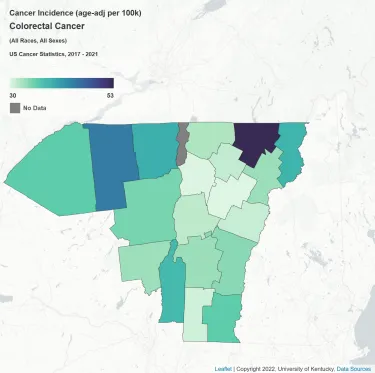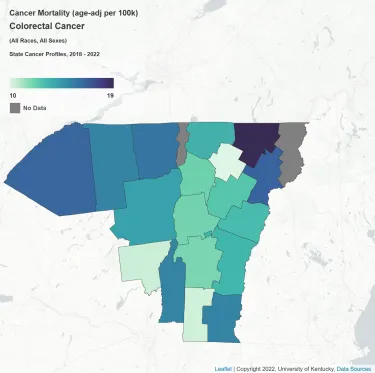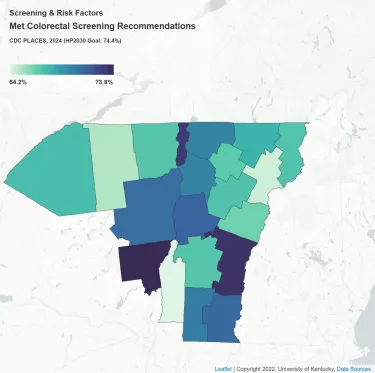
Did You Know?
Colorectal cancer is the 2nd leading cause of cancer-related deaths in the US.
1 in 24 people will get colorectal cancer in their lifetime.
When caught early, the survival rate is 91%.
1 in 5 new cases are among people younger than 54.
54% of colorectal cancers are linked to modifiable risk factors.
Colorectal Cancer Resources
What is Colorectal Cancer?
Cancer is a disease where cells grow out of control and spread to other parts of the body. When this type of growth begins in the colon or rectum, it’s called colorectal cancer. Most colorectal cancers begin as a noncancerous growth, called a polyp, in the inner lining of the colon or rectum. Polyps are common, and most do not become cancerous. Those that do, progress slowly, allowing for cancer prevention through their detection and removal during colorectal cancer screening.
Signs and Symptoms
People with early-stage colorectal cancer are typically asymptomatic. This is why regular screening is essential!
Signs and Symptoms to Look For:
- Rectal bleeding with bright red blood
- A change in bowel habits, such as diarrhea, constipation, or narrow stools, that lasts for more than a few days
- A feeling that you need to have a bowel movement that’s not relieved by having one
- Blood in the stool, which might make the stool look dark brown or black
- Cramping or abdominal pain
- Weakness and fatigue
- Unexplained weight loss
Many of these symptoms can be caused by conditions other than colorectal cancer. Keeping a record of changes over time can be helpful. Remember, you know your body best. If something doesn’t feel right, speak up.
Tracking Symptoms and Advocating for Your Health
- Keep a health journal: Record any new symptoms, including frequency, duration, and patterns. This can be a helpful tool for your doctor.
Know your family history: Share your family history of colorectal cancer with your doctor. This is important for creating a personalized screening plan, especially if you’re at higher risk.
Ask about screening: Screening saves lives. If you’re 45 or older, have a family history of colorectal cancer, or have other risk factors, talk to your doctor about screening options. Even if you’re younger and experiencing symptoms, it’s okay to push for a screening referral if you feel it’s needed.
Speak up if symptoms persist: Don’t ignore symptoms that stick around or get worse. Persistent symptoms deserve attention, especially if they’re new or worsening.
Sources: American Cancer Society and Cheeky Charity, 2025
Risk Factors
What is a risk factor? A risk factor is anything that increases your chances of getting a disease, such as cancer.
Hereditary or medical risk factors for colorectal cancer include:
- Personal or family history of colorectal cancer
- Certain genetic disorders (including Lynch syndrome and familial adenomatous polyposis)
- Chronic inflammatory bowel disease (including ulcerative colitis and Crohn's disease)
- Type 2 diabetes
Potentially modifiable risk factors for colorectal cancer include:
- Excess body weight
- Physical inactivity
- Smoking
- High consumption of red or processed meat
- Heavy alcohol consumption
- Low intake of calcium, whole-grain, and/or fiber-rich foods
If you have a family or personal history that puts you at higher risk for colorectal cancer, talk with your healthcare provider about an early or personalized screening plan.
Source: American Cancer Society, 2025
Screening Options
If you are ≥45 and of average risk, it's time to get screened.
There are many different options for colorectal cancer screening! They can be categorized into visual-exam tests or stool-based tests.
| Visual-Exam Tests | Stool-Based Tests | |
|---|---|---|
| About |
|
|
| Options |
|
|
The most important thing is to get screened, no matter which test you choose.
Source: American Cancer Society, 2025
Prevention
Diet
- Adding fiber-rich foods, including fruits, vegetables, and whole-grains, can promote colon health and lower cancer risk.
Smoking
- Avoid starting smoking or consider quitting.
Alcohol Use
- Aim to stay within recommended limits or avoid alcohol to reduce your cancer risk.
Physical Activity
- Physical activity can regulate some hormones that contribute to the development of cancer, keep the immune system healthy, and can help you stay at a healthy weight.
Resources
- VT Department of Health Physical Activity and Nutrition Program works to make healthy foods and opportunities for exercise more accessible to all Vermonters.
- 802Quits provides free help, including personalized quit plans, to quit smoking, vaping, or any other tobacco or nicotine produce use.
- ACS CancerRisk360 is an educational resource that empowers individuals with information to support overall health and understand factors that may reduce the risk of cancer.
Colorectal Cancer in Our Catchment Area (VT and Northern NY)
Incidence
Age-adjusted incidence for colorectal cancer ranges from 30 per 100,000 in Washington County, VT to 53 per 100,000 in Orleans County, VT.

Source: Cancer inFocus, 2025
Mortality
Age-adjusted mortality for colorectal cancer ranges from 10 per 100,000 in Lamoille County, VT to 19 per 100,000 in Orleans County, VT.

Source: Cancer inFocus, 2025
Screening
Meeting screening recommendations for colorectal cancer range from 64% in Washington County, NY to 74% in Warren County, NY.

Source: Cancer inFocus, 2025
Clinical advisor: Jesse Moore, MD, Colon and Rectal Surgeon, University of Vermont Medical Center
For questions about the colorectal cancer program, please contact the Community Outreach and Engagement Team at COE@med.uvm.edu






